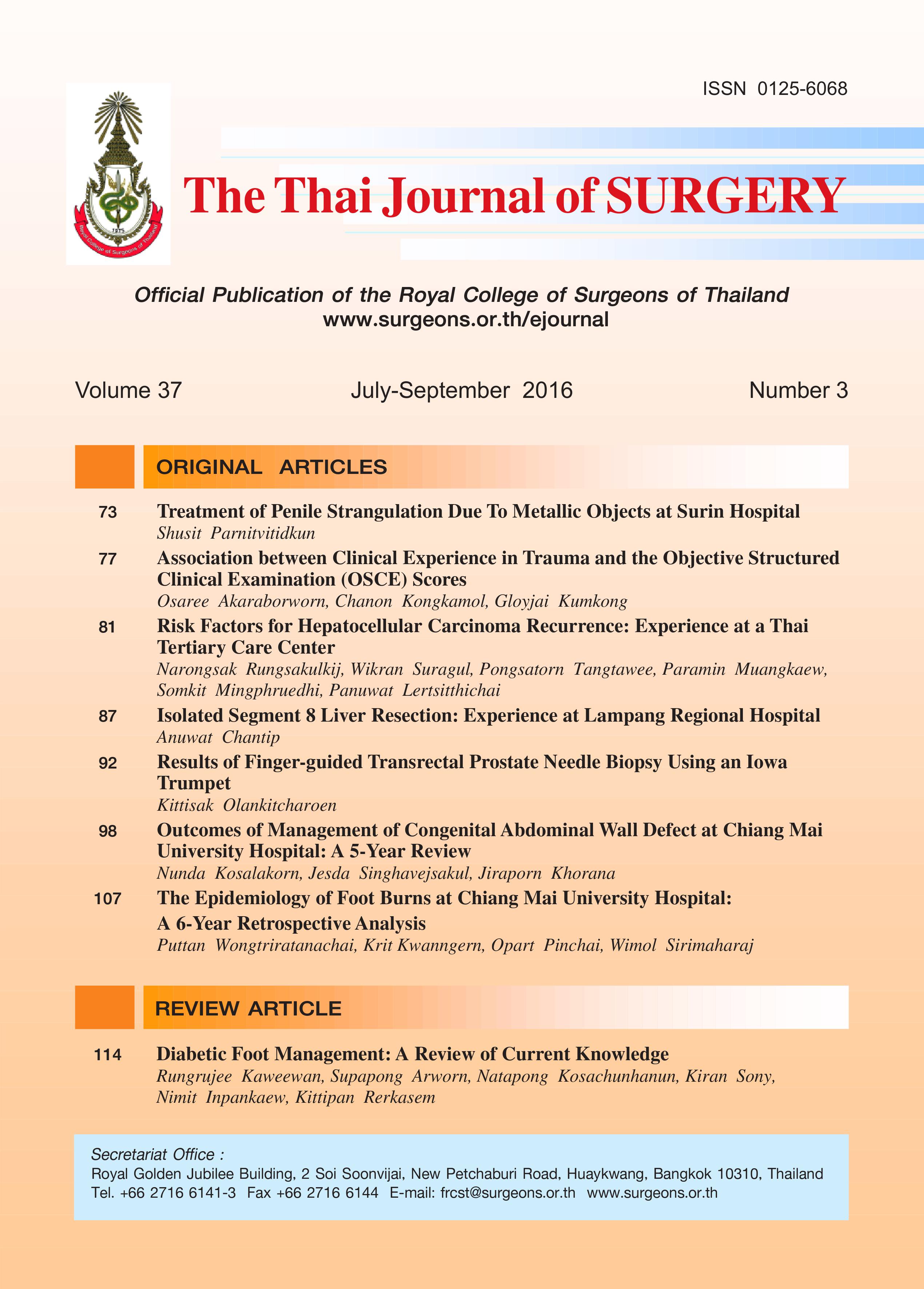Results of Finger-guided Transrectal Prostate Needle Biopsy Using an Iowa Trumpet
Keywords:
Finger guided, transrectal prostate biopsy, Iowa trumpetAbstract
Background and Objective: Currently, the gold standard diagnosis of prostate cancer is transrectal ultrasound(TRUS)-guided prostate needle biopsy, obtaining 8 to 10 cores. Because Tak Hospital lacks a transrectal ultrasound,
finger-guided transrectal prostate biopsy using an Iowa trumpet was used. The aim of this study was to determine the
diagnostic values of this technique.
Methods: This retrospective study collected data from the hospital database from January 2006 to December
2015. Indications for biopsy included high prostate specific antigen (PSA) level (≥ 4 ng/mL) or abnormal findings
on digital rectal examination (DRE). Repeat biopsy was indicated in patients with rising PSA (> 0.85 ng/mL/year).
Patients with urinary tract infection and bleeding tendency were excluded. Pathological reports, PSA, and DRE
results were collected.
Results: Two hundred and fifty-two patients were included and 286 biopsies were performed. Cancer detection
rate at initial biopsy was 44%, and at the first repeat biopsy 17%. The sensitivity, specificity and positive predictive
value for PSA ≥ 4 ng/mL were 98.2%, 5.0% and 44.9%, respectively; for PSA level > 10 ng/mL these were 87.4%,
61.7% and 64.2%, respectively; for abnormal DRE, these were 90.1%, 87.9% and 85.5%, respectively; and for PSA
≥ 4ng/mL with abnormal DRE these were 88.3%, 92.9% and 90.7%, respectively. The major complications were seen
in 5% (most were infectious complication) and minor complications 9% (most were difficult urination, dysuria and
urinary retention) of patients.
Conclusion: Finger-guided transrectal prostate needle biopsy using an Iowa trumpet is equally as effective as
the standard TRUS-guided diagnosis of prostate cancer. Its complications are acceptable and comparable to the
standard TRUS-guided methods.
References
3rd ed. Atlanta: American Cancer Society; 2015.
2. National Cancer Institute of Thailand. Annual report 2012.
Hospital-based cancer registry. Bangkok: Ministry of Health;
2014:3-5.
3. Hilton WM, Padalecki SS, Ankerst DP, Leach RJ, Thompson
IM. Temporal changes in the clinical approach to diagnosing
prostate cancer. J Natl Cancer Inst Monogr 2012;45:162-8.
4. Thai Urological Association under the Royal Patronage.
Guideline of prostate cancer [Internet]. 2015 [cited 2016
Jan]; Available from: http://www.tuanet.org/files/tua-hotupdate/
Guileline-CAP-TUA.pdf
5. Mistry K, Cable G. Meta-analysis of prostate specific antigen
and digital rectal examination as screening tests for prostate
carcinoma. J Am Board Fam Pract 2003;16:95-101.
6. Wiwanitkit V. Prostate specific antigen for screening for
prostate cancer: an appraisal of Thai reports. Asian Pacific
J Cancer Prev 2004;5:406-8.
7. Udomphot C, Lojanapiwat B, Jun-U J. PSA level and result of
prostate biopsy in 10 years in Maharaj Nakorn Chiang Mai
Hospital. Thai J Urol 2012;33:9-15.
8. Tze Kiat Ng, Vasilareas D, Mitterdorfer AJ, Maher PO, Lalak A.
Prostate cancer detection with digital rectal examination,
prostate specific antigen, transrectal ultrasonography and
biopsy in clinical urological practice. BJU International 2005;
95:545-8.
9. Loeb S, Velleckoop A, Ahmed HU, et al. Systematic review
of complications of prostate biopsy. Eur Urol 2013;64:876-
892.
10. Santanapipatkul K, Nualyong C, Srinualnad S, et al. Factors
predicting complications after transrectal ultrasound guided
prostate biopsy. Thai J Urol 2013;34:38-48.
Downloads
Published
How to Cite
Issue
Section
License
Articles must be contributed solely to The Thai Journal of Surgery and when published become the property of the Royal College of Surgeons of Thailand. The Royal College of Surgeons of Thailand reserves copyright on all published materials and such materials may not be reproduced in any form without the written permission.



